Planet Parade
Autumn 2022 sees a wonderful parade of planets in our night sky.
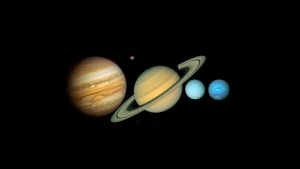
Planet Montage. Photo: NASA
Jupiter, Saturn, Uranus and Neptune are followed later by Mars.
And the Moon joins in to provide something special on September 14th.
Here’s our Wonderdome guide to his planet parade.
All in a row
The brightest of these distant worlds is mighty Jupiter.
In September and October it shines brighter than any star.
You will see it low in the south.
To its right is Saturn, also low and bright.
Away to Jupiter’s left, Mars rises in the eastern sky as Saturn sets in the west.
The two ice giants, Uranus and Neptune are also in line.
However you will need a telescope to view this pair of distant worlds.
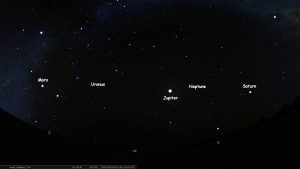
Planet parade. Image:Stellarium
Stellarium
As usual, our views of the night sky come by courtesy of Stellarium.
Stellarium gives a superb rendition of the night sky on a PC, tablet or smart phone.
We can see the sky at any time on any date of any year.
It’s the software we use in Wonderdome Planetarium.
And it’s free to use! Download it here at Stellarium.
Jupiter
Jupiter is the brightest of the planets on parade.
It will be at its closest to Earth on September 26th.
Its distance then will be 590 million km, 373 million miles.
Jupiter and moons, small telescope. Photo: Dennis Ashton
Through a small telescope, you can see dark cloud bands and light zones on Jupiter.
You can also make out the four moons discovered by Galileo in 1610.
They are Io, Europa, Ganymede and Callisto.
These tiny dots change position each night as the moons orbit their parent planet.
Actually, if you have a pair of binoculars, you will be able to see these moons.
Your binoculars are probably better than Galileo’s primitive telescope!
Jupiter quick facts
- The largest planet, almost 140,000 km across.
- About 1200 Earths could fit inside Jupiter.
- It is a gas giant planet.
- It spins round the fastest of all planets, in only 9 hours, 55 minutes.
- This fast rotation makes it bulge out at its equator.
- Jupiter takes around 12 years to orbit the Sun.
- It orbits 5.2 times further from the Sun than Earth.
- Jupiter has 79 moons and thin rings.
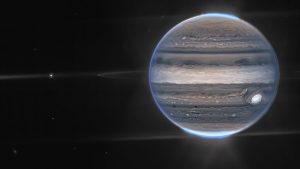
Jupiter, Webb Telescope. Image: NASA, ESA, CSA
Recently the James Webb Space Telescope returned a wonderful image of Jupiter.
It’s infra-red eye shows cloud belts, storms, aurorae and Jupiter’s thin ring.
Saturn
Look to the right of Jupiter to find Saturn.
Saturn is low in the sky, so not easy to observe.
Saturn came nearest to Earth in August, when it was about 750 million miles away (1.2 billion km)
The best time to see it is early September.
Jupiter & Saturn in night sky. Image: Stellarium
A small telescope will reveal the rings and perhaps one or two of its larger moons.
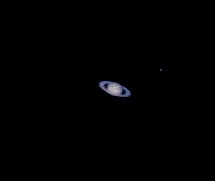
Saturn, small telescope. Photo: Dennis Ashton
Saturn quick facts
- 120, 600 km wide, almost 10 times wider than Earth
- 750 Earths could fit inside Saturn.
- Saturns rings are 282,000 km across but less than one kilometre deep.
- The rings are made of chunks of ice and rock.
- A day on Saturn is only 10 hours, 39 minutes.
- Saturn takes over 29 years to orbit the Sun.
- It orbits at 9.5 times the distance of Earth from the Sun.
- It is a gas giant, made of mainly hydrogen. It could float on water!
- Saturn has 82 moons, more than any other planet.
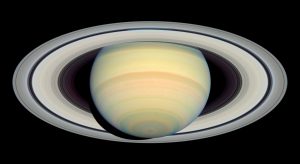
Saturn from the Cassini spacecraft. Image: NASA
Mars
Mars brings up the rear of our planet parade.
It rises later than the other planets so you will have to wait until later in the night to see it.
Look well to the left of Jupiter to find the orange-red disc of Mars.
The red planet is closest to earth on December 8th so it is best seen in late autumn / early winter this year.
Its distance will be around 50 million miles, 80 million km.
Mars appears close to a red star.
This is the red giant star Aldebaran, the glowering eye of Taurus the Bull.
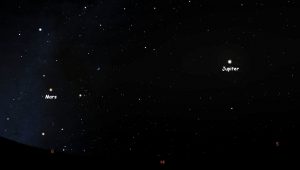
Mars and Jupiter. Stellarium
A small telescope will resolve light and dark areas in the landscape of Mars.
When our atmosphere is still you may glimpse the polar ice caps.
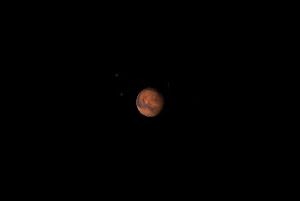
Mars, small telescope:. Image: Stellarium
Mars quick facts
- Around 6, 800 km across, less than half the diameter of Earth
- Mars orbits the Sun in 687 days.
- Its average distance from the Sun is about 228 million km.
- A day on Mars is similar to a day on Earth, 24 hours and 40 minutes.
- It is cold. The surface temperature varies from minus 90 degrees C to around zero C.
- The Olympus Mons volcano is the biggest in the Solar System, 600 km wide and 27 km high.
- Mariner Valley is 4,200km long and 7 km deep.
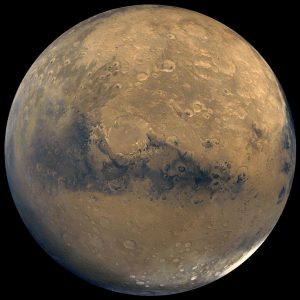
Planet Mars. Image: NASA
Uranus
Uranus comes nearest to Earth on November 9th.
It will then be around 1.8 billion miles away, 2.8 billion km.
You can find it with a telescope between Jupiter and Mars.
Stellarium will show you its precise position.

Uranus through a small telescope. Image: Stellarium
Uranus appears as a tiny green-blue disc in a backyard telescope.
Although there is little detail to see, it’s exciting to view this world, the first to be discovered using a telescope.
Uranus quick facts
- Discovered in 1781 by Sir William Herschel
- Takes 84 years to orbit the Sun
- Uranus is around 2, 870 million km away.
- It is 19 times further from the Sun than Earth.
- Spins round in 17 hours, 14 minutes
- It’s axis is titled 98 degrees so it orbits on its side!
- Uranus is the coldest planet, with a temperature dropping to minus 224 Celsius.
- It is an ice giant. Below the hydrogen atmosphere is an icy mantle and core.
- Methane ice crystals give Uranus its green- blue colour
- Uranus has 27 known moons.
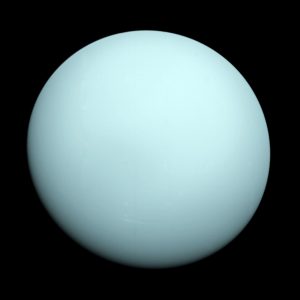
Uranus, Voyager 2. Image: NASA
Neptune
Neptune is the most distant planet in our parade.
You definitely require a telescope to see it.
Through a small telescope, Neptune is a tiny blue disc.
The best time to search for it is around September 26th, when it is at its closest point to us.
Even so Neptune will still be 2.7 billion miles away, 4.3 billion km.
Again, Stellarium will help you to locate this distant planet.
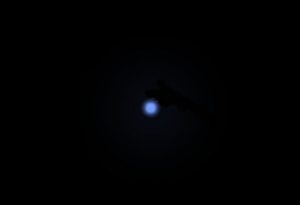
Neptune, small telescope. Image: Stellarium
As with Uranus, no real detail can be seen but it’s very satisfying to find the most distant regular planet of the Solar System.
Neptune quick facts
- Discovered in 1846 by a combination of three astronomers, Urban Le Verrier, John Couch Adams and Johan Galle
- Rotates in around 16 hours
- Neptune’s mean distance from the Sun is around 4,500 million km.
- It is 30 times further from the Sun than our Earth.
- It takes 165 years to complete one orbit of the Sun.
- Like Uranus, Neptune is an ‘ice giant’ planet.
- Methane gas gives Neptune its blue colour.
- Neptune has dramatic storms with winds over 1000 km per hour.
- Only one space probe has visited Neptune. This was Voyager 2, which also flew by Uranus.
- Neptune has 14 moons.
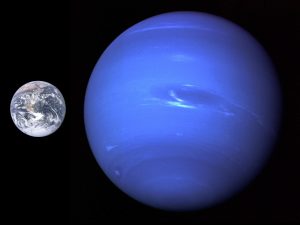
Neptune compared to Earth. Image: NASA
The Moon joins the party
Our Moon will pass by the planets in the coming weeks.
It will also pass in front of one of them, a lunar occultation.
The Moon appears close to Saturn on September 8th and 9th.
It’s near Jupiter on the 12th of September.
Because Neptune is near Jupiter in our sky view, the Moon is closest on September 11th.
For Mars, the Moon encounter is on September 17th.
But the main event takes place on September 14th.
That night, the Moon doesn’t just lie close to Uranus, it passes in front of the planet.
This is an occultation which doesn’t happen very often.
The bright left-hand side of the Moon will encounter Uranus at around 10.25 pm.
Uranus will emerge from the dark side of the Moon at about 11.20 pm.
So the occultation will take about an hour.
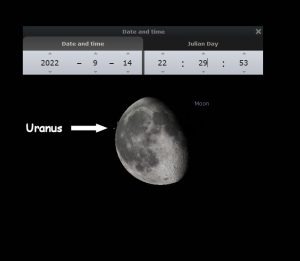
Occultation of Uranus. Image: Stellarium
You will need a telescope to watch this very special celestial event.
Or you can simulate it at any time through the brilliant Stellarium.
I wish you clear nights for the 2022 Planet Parade!
The author: Dennis Ashton is a Fellow of the Royal Astronomical Society and a Wonderdome presenter.
Would you like to hear more Astronomy news?
Do you want to to find out about our upcoming public events?
Follow WonderDome Portable Planetarium on Twitter and Facebook or go to our web site wonderdome.co.uk!



